I’m feel something big is coming for crypto. Something very bullish.
I’m not sure what’s coming but there are significant changes in the market.
Interest rate reductions starting, ETH ETF approval, BTC ETF increasing inflows, Stripe launching stablecoin payments….
Just as an army positions itself before a decisive battle, major crypto companies and TradFi are gearing up for the upcoming bull run.
More on this “feeling” in the post below:
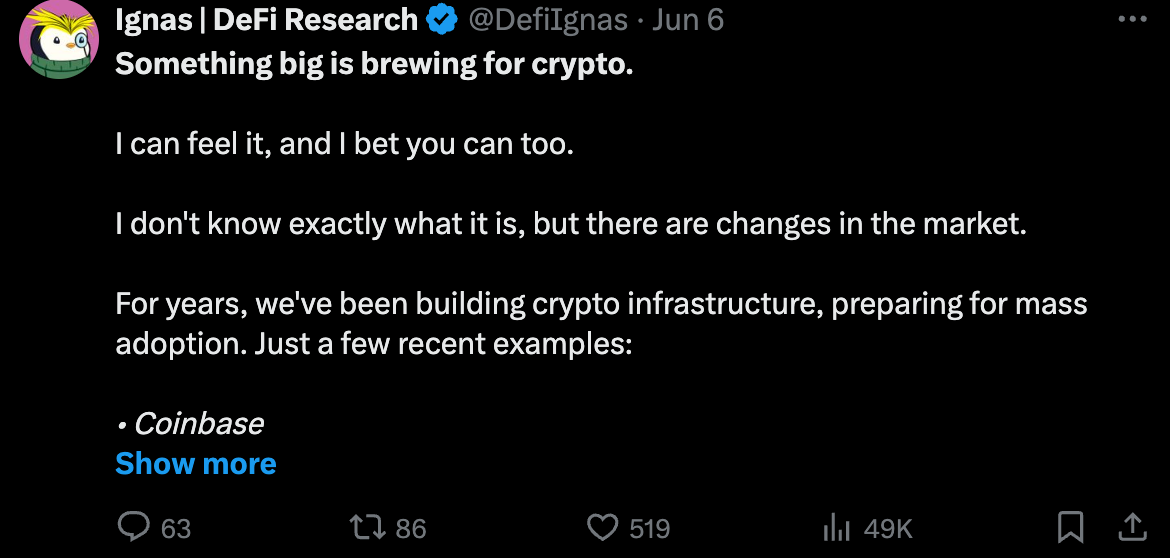
At the same time, the internal crypto machine doesn’t stop moving. Yes, prices are going down…
…but there are always changes in the market and new narratives and trends emerge that influence the market as they grow stronger.
Just as MakerDAO launched before the term "DeFi" was even coined, new trends are emerging in the market right now that are still too small to form a coherent story.
Here are 7 emerging trends that might significantly impact the market.
Airdrop Farms of the Week
- Catalyst: cross-chain AMM designed to connect different blockchains for easy swaps and liquidity sharing across chains. Powered by Wormhole.
- Currently only ETH swaps between Optimism, Blast, and Base are available.
- On May 21 Catalyst launched Eggs Rewards and distributed weekly for 10 weeks to reward users for LPying and swapping.
- Loyalty Score: Tracks your activity over time, ranging from 0-100. Stay active to increase your score. While it doesn’t affect the number of Eggs you get, it influences what hatches from them.

- Use my referral for 7% kickback. If you use my code and earn 100 Eggs, you will get 7 extra Eggs as a kickback.→ Join here
- Farcaster: You must be new in crypto if you don’t know it already. And it’s a mistake if you don’t have an account yet.
- Farcaster recently raised $150m at $1B valution from Paradigm, a16z, etc.
- Reports came out that Farcaster might launch a token. Does it mean airdrop?
- In this case, join with my invite to earn 50 Warp tokens that are used to mint NFTs, create channels, and more. Join here.
- Zircuit: An L2 that can be the next big airdrop and token launch is probably soon. It seems that they keep it too quiet.
It’s backed by Pantera & Dragonfly, and Binance just announced investment. It’s integrated by major LRT protocols so you can farm LRT + Zircuit airdrop at once. Deposit your LRT ETH for 2x points. You can withdraw anytime you want.
→Join here with my code: tt2e5v
 I think DALL-E with ChatGPT 4o is finally getting better.
I think DALL-E with ChatGPT 4o is finally getting better.
1. Repackaging
Old coins are boring and degens want new stuff.
What if you could change your brand name, create a new token ticker, and start fresh with a new chart? That sounds much more exciting!
Fantom → Sonic
It’s exactly what Fantom is doing with the Sonic upgrade.
Sonic is a new L1 with a native L2 bridge to Ethereum. It will have new Sonic Foundation & Labs as well as totally new visual identity.
More importantly, the new to $S token “ensures compatibility and migration between $FTM to $S on a 1:1 basis.”
Smart move, as the Sonic migration generates more market hype than simply calling it "Fantom 2.0." This allows Fantom to leave its Multichain bridge issues behind and start fresh.
Subscribe
Connext → Everclear
Similarly, Connext is rebranding to Everclear.
Rebranding is nothing new in crypto, but the emerging trend here is repackaging significant upgrades as a new product.
It sends stronger signal to the market than just another v2 or v3 upgrade. People don’t get too hyped on just another “v4” upgrade.
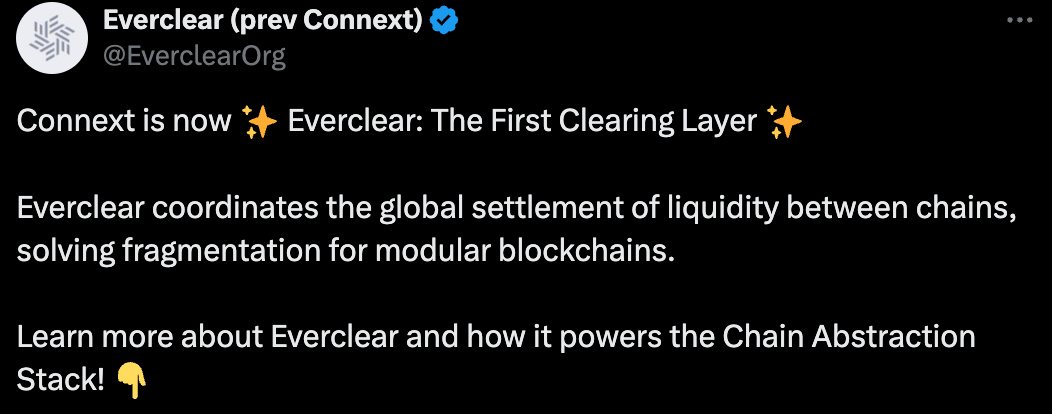
By switching from Connext to Everclear, the team signals that this is more than a simple rebranding; it represents significant advancements in tech progress.
Connext moves from simple bridging infrastructure to the first Clearing Layer. It’s like a chain in itself built as an Arbitrum Orbit rollup (via Gelato RaaS) and uses Hyperlane with an Eigenlayer ISM to connect to other chains.
Connect any chain, any asset for the modular crypto future.
NEXT token price went up by ~38% on the news (but didn’t hold). Fantom’s $FTM was trading hot once again and their mindshare on X has increased as well.
I expect more protocols will rebrand to fit the market trends and technical advancements of 2024.
E.g., IOTA is rebranding as an L2 for real worlds assets.
Moreover, mergers might become more common as Fetch ai, Ocean protocol, and SingularityNet merged under one $ASI token with a new chart for a crypto super AI project.
The key here is following the price performance of the newly rebranded projects and new tickers (if launched). Early to say, but initial price performance of FTM and NEXT as well as FET, AGIX, and OCEAN is optimistic. If only the market started to pump again…
Are there more repackaging/rebrands coming soon?
2. Pro-Crypto Regulation
Regulation has been a significant pain in the arse, particularly in the US, where the SEC has targeted key players like Coinbase, Kraken, and Uniswap. Despite wins for Ripple and Grayscale, and the approval of Bitcoin ETFs, the regulatory environment has remained hostile, focusing more on legitimate projects rather than outright scams.
But there’s been a change: Trump is verbally pro crypto forcing Democrats to shift their anti-crypto strategy. Biden is accepting donations with crypto. And now SEC drops the lawsuit against Consensys, de-facto admitting that ETH is a commodity.
Now, the short-term future of crypto will depend on the elections. I liked the analysis by Felix (Hartmann Capital) from the article below.
Here are the main points.
If Gensler is ousted or his power checked by courts and Congress, expect a sharp 30%+ rally in crypto assets followed by a sustained bull market. If he remains in power, expect a prolonged downturn where law firms benefit, and crypto and taxpayers lose, with only Bitcoin and memecoins remaining relatively unaffected.
Regulatory clarity could bring in the greatest bull market yet, transforming the digital asset market in several ways:
- Shift from Narratives to Product Market Fit: Crypto projects will focus on creating value-driven products rather than just hype, leading to higher quality developments.
- Clear Metrics for Success: Valuations will rely more on actual product market fit and earnings, reducing speculation and highlighting fundamentally strong tokens.
- Easier Funding Environment: Stronger fundamentals will make it easier for digital assets to secure funding, reducing the cyclical rise and fall of altcoins.
- Thriving M&A Market: Well-funded projects could acquire under-capitalized but valuable DeFi protocols, driving innovation and closer adoption, with some Layer 1 blockchains turning acquisitions into public goods to increase network value.
3. BTC Carry Trade: BTC ETF + BTC shorts
Leverage always finds new ways to creep into the system. Either it’s Grayscale’s “widowmaker trade” or uncollateralized lending by CeFi (Celsius, Blockfi, etc.).
Every cycle the mechanism is different. But where is the leverage hiding right now?
The obvious target is Ethena with delta neutral strategies. As long as funding rate is positive all is good, but what if/when funding rate goes negative and USDe positions need to be closed?
Another one is Restaking with LRTs.
But one more target emerged to be our beloved BTC ETF buyers.
Spot Bitcoin ETFs saw positive flows for 19 straight days with 5.2% of all BTC in circulation being held in ETFs (although the streak is broken for now).
So, why isn’t BTC sky rocketing?
In turns out, hedge funds are shorting Bitcoin with CME Futures at the record rate.
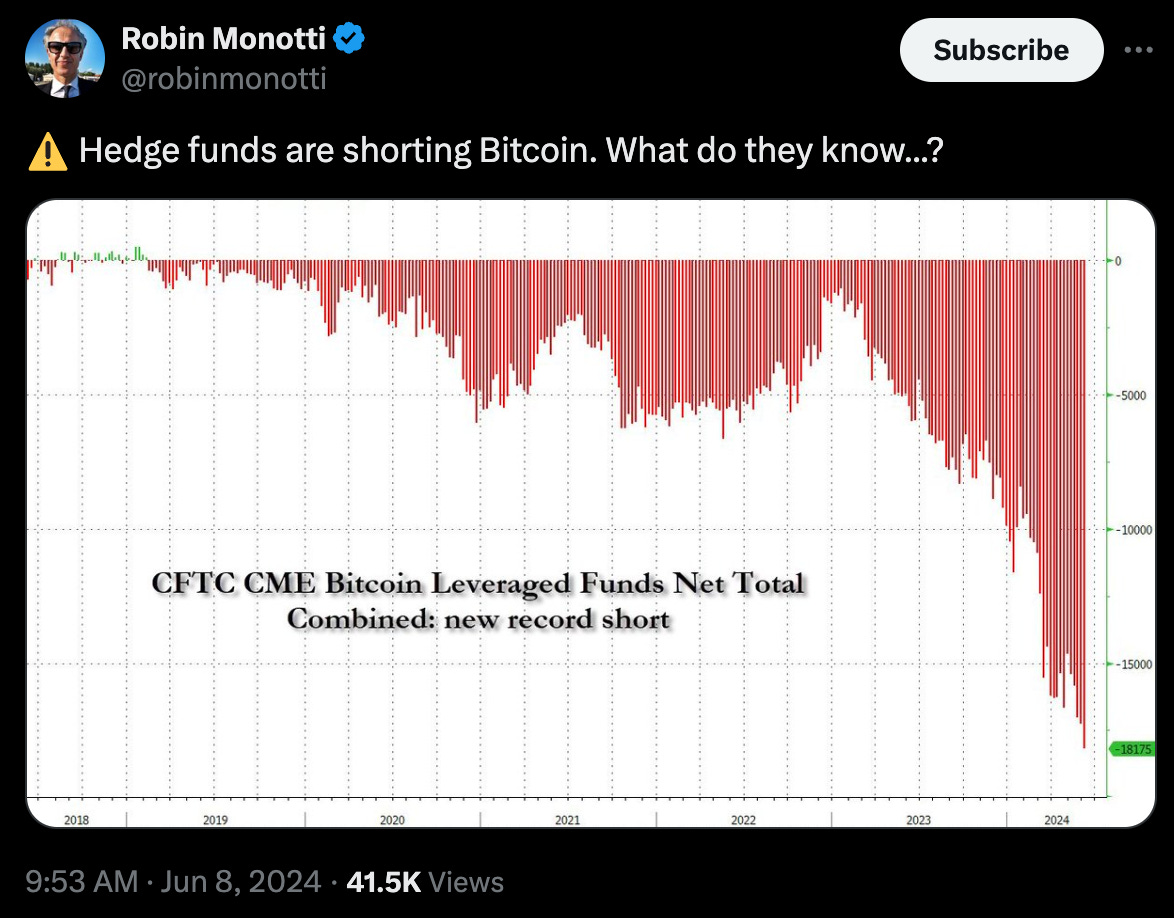
"What if massive lev at low funding is this cycle’s lev and is already here” - Kamizak ETH
Possible explanation is that hedge funds buy spot and short BTC for 15%-20% delta neutral strategy.
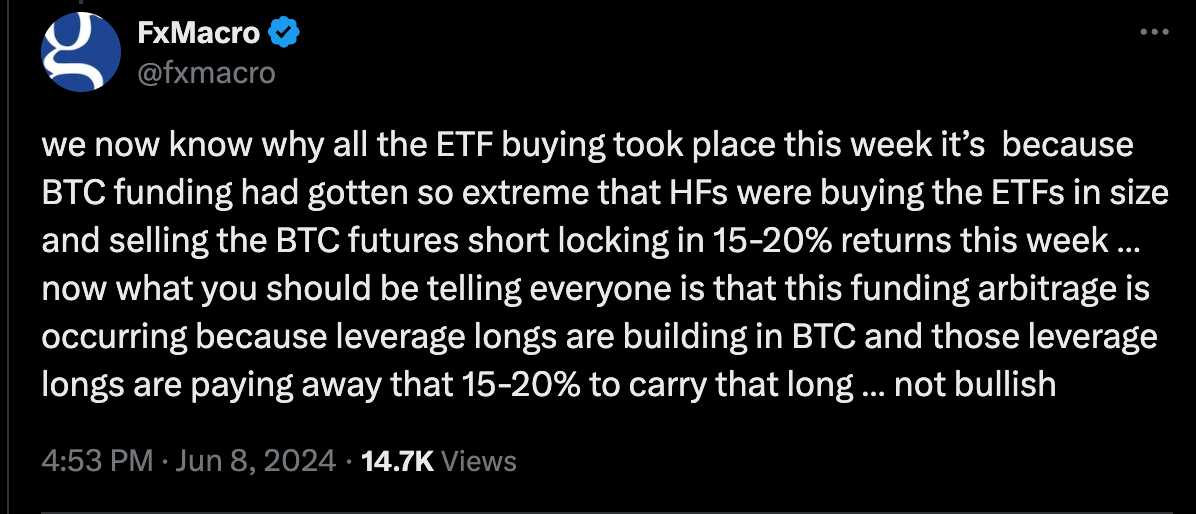
Strategy is same as Ethena. "What if massive lev at low funding is this cycle’s lev and is already here” - Kamizak ETH
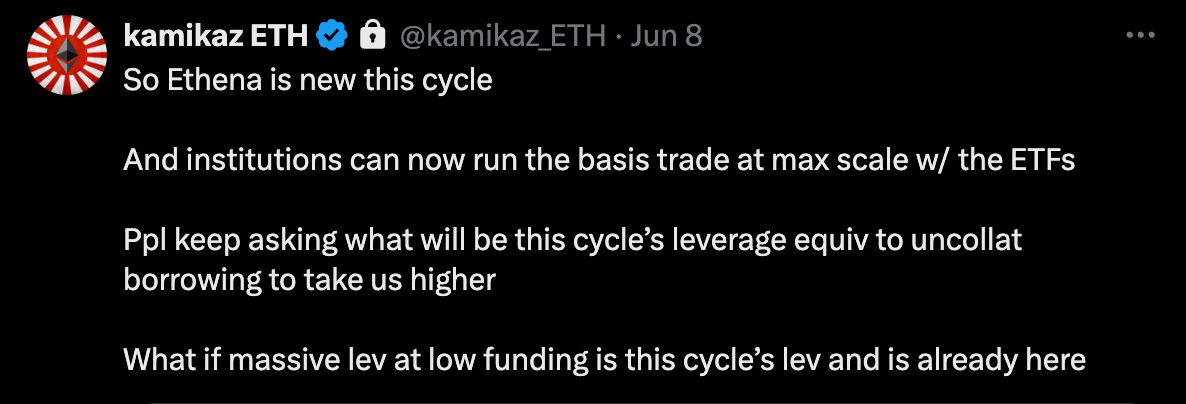
What happens when funding goes negative (as degens stop being bullish and close long positions)?
Can Ethena (dominated by retail users) and spot BTC + short CME futures (dominated by institutions) lead to a major crash when those positions need to be unwinded?

Scary. But perhaps there’s a simpler answer: Institutions are arbing the positive price between different BTC spot and BTC futures (which stands at 2.3%).
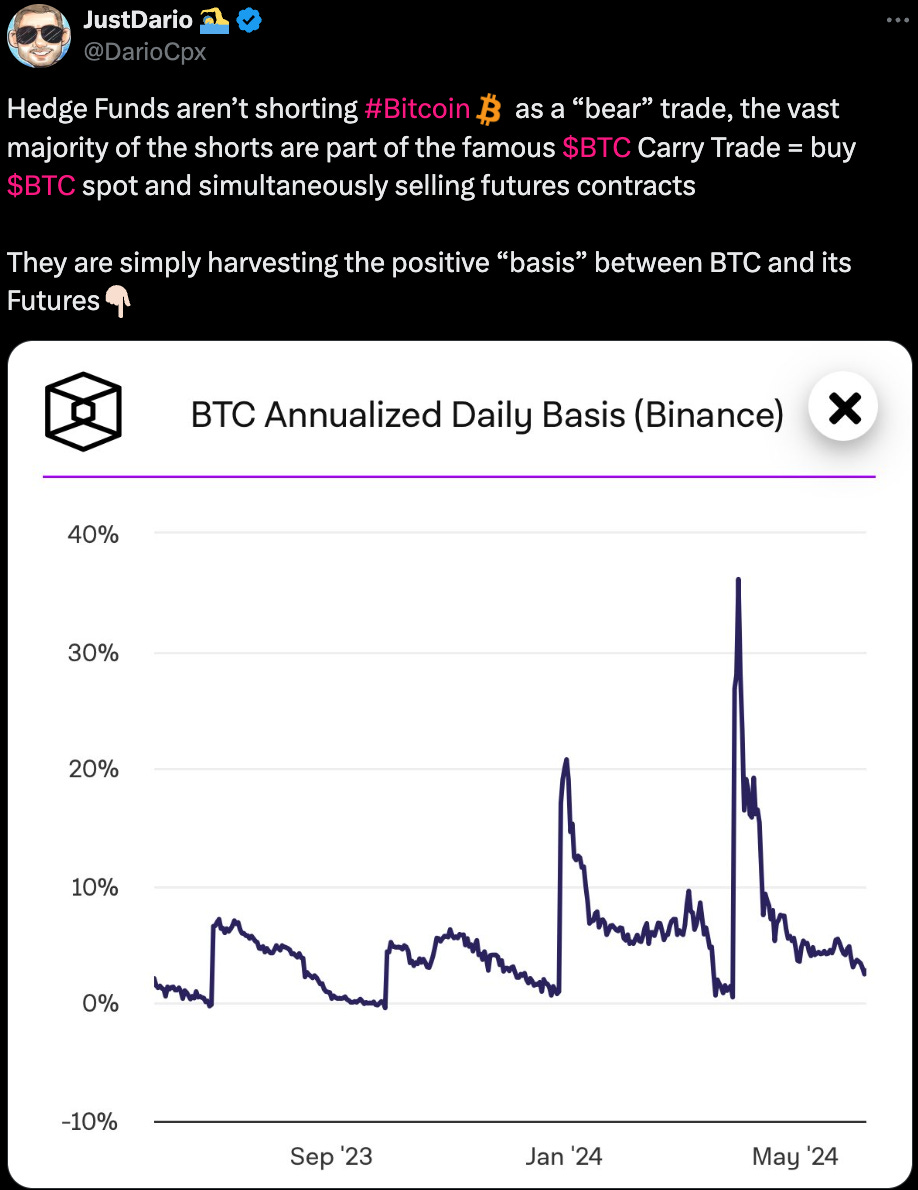
In any case, these new dynamics brought by spot ETFs need to be followed closely as often ‘risk-free’ arbitrage ends up ‘more-risk’ than initially thought.
4. Point Farming Gamification
Our points addiction is getting worse, but we don’t know how to stop it.
Protocols need points to attract initial user base. And they help to boost adoption stats to raise at higher valuation.
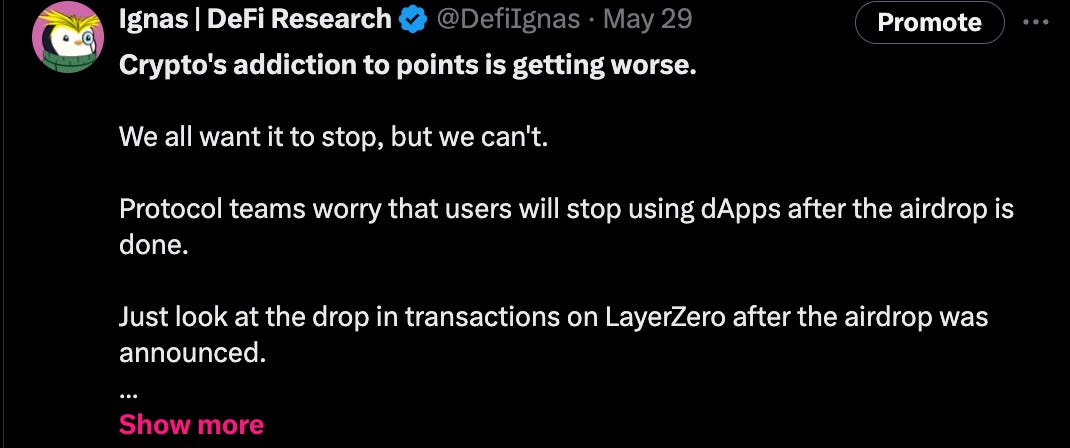
We’re tired of points, but no better alternative is available. Yet.
Instead, I’ve noticed a gamification of points trend that adds extra elements to the boring point farming strategy.
Sanctum introduced Wonderland, where you collect pets and earn experience points (EXP) to level them up. As a community, you'll need to group together to tackle quests.
It’s not much different from other point programs as your airdrop largely depends on deposited SOL, but… the community LOVED IT!

The fact that Sanctum ran the season 1 campaign for just a month also boosted the sentiment around it.
Blackwing, too, added a fun twist to the point airdrop farming. You can trade your earned points - BXP - (from deposits) to Blackwing’s testnet USD (BUSD) and trade in the platform to earn more BXP.
If you’re great at trading, you could potentially earn higher airdrop allocation than whales who simple deposit assets.
→ If you want to try it out, join with my referral here.
I’d love to see 0-to-1 innovations in airdrop farming, but even with point fatigue, our addiction to them is too strong.
Instead, I expect to see more gamification attempts to bring back some fun to the farming.
5. Anti-Trend of Low-Float, High-FDV Launches
Everyone hates low-float, high-FDV launches. Except for the VCs and team, that can sell at higher prices. Oh, and airdrop farmooors, who get more $ in airdrops.
But retail? Nah. 26 out of 31 recently listed tokens on Binance are in red.
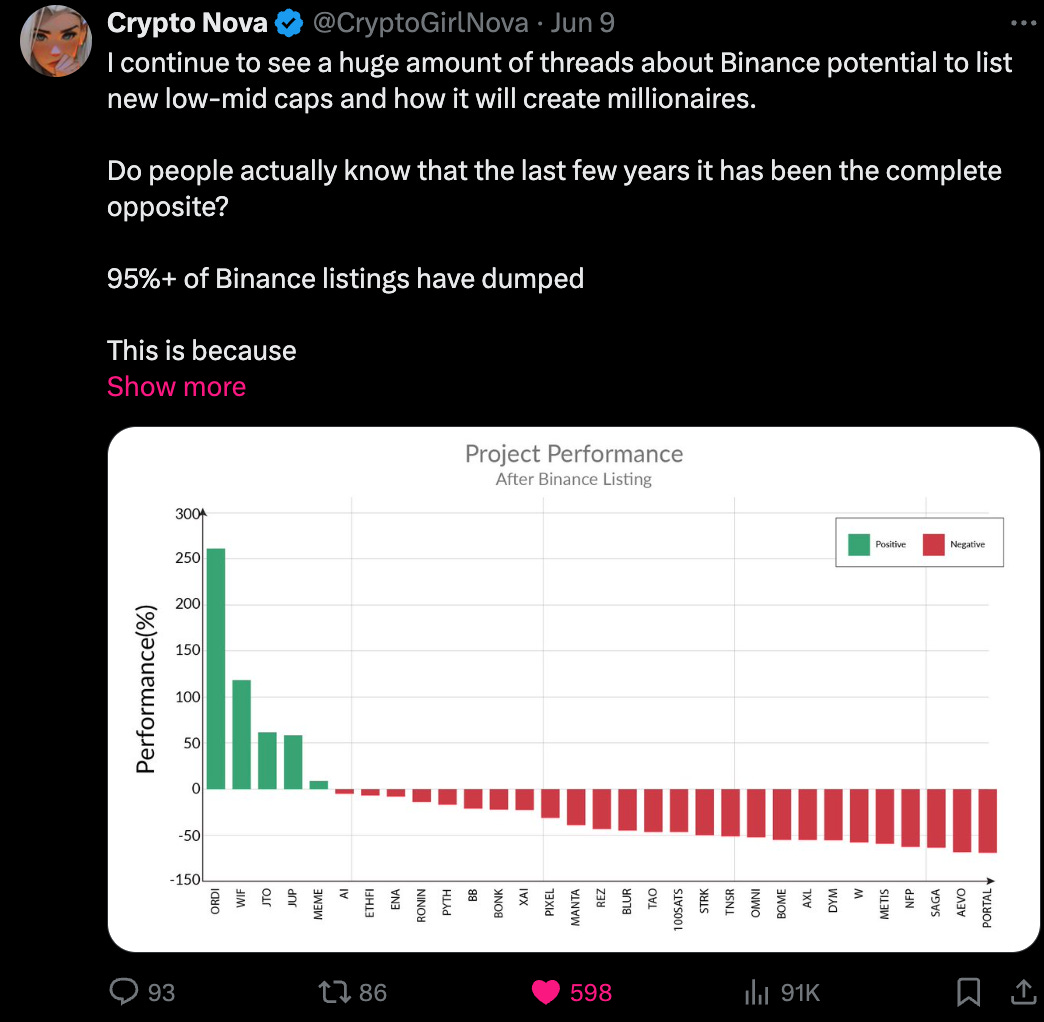
Binance used to be the place to buy hot new tokens, but that’s not the case anymore. CEX listing is the sell the news and cashing out event.
No surprise that Binance recently announced listing tokens with modest valuations, prioritizing community rewards over insider allocations.
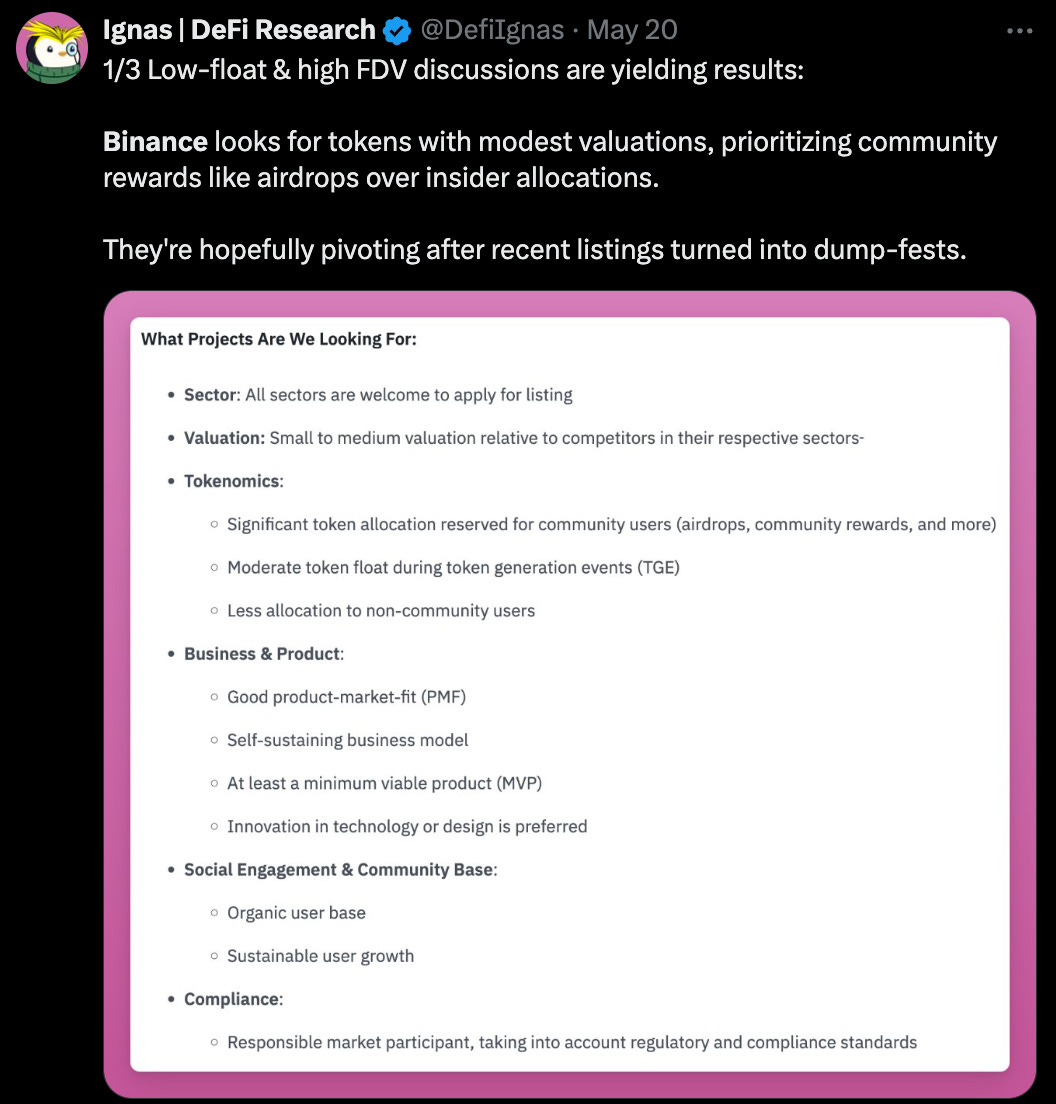
We’re still to see words convert to actions but it would be a step in a right direction.
VCs are getting their share of the blame. Once seen as a positive signal, large VC investments are now viewed by the crypto community as value-extractive. The concern is that VCs aim to profit by selling their substantial allocations, which they acquired for minimal cost.
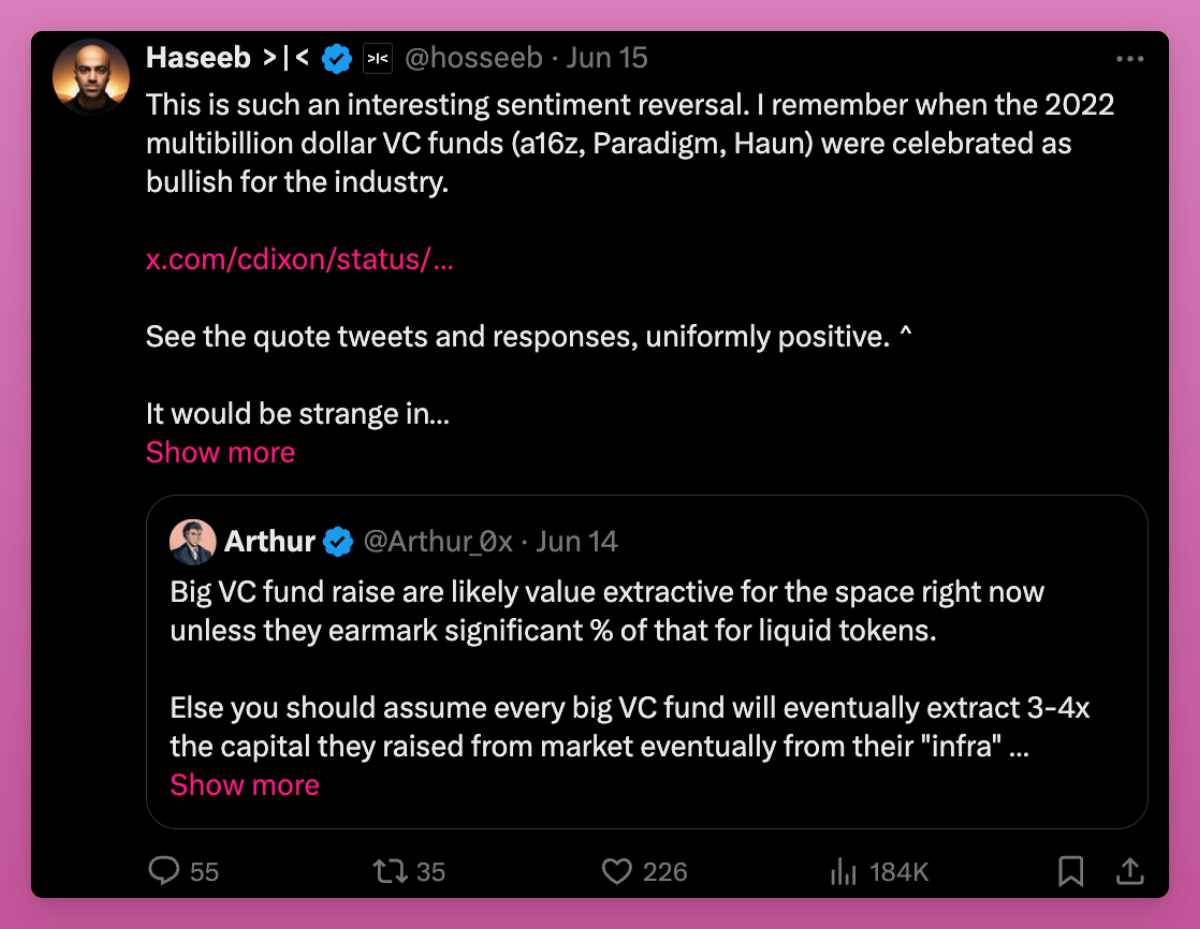
Project teams, too, must act to avoid the forever-down price charts.
There’s more experimentation from protocol side as well. Ekubo on Starknet, for example, distributed 1/3rd of the tokens to users, 1/3rd to team, and 1/3rd to be sold by the DAO over two months.
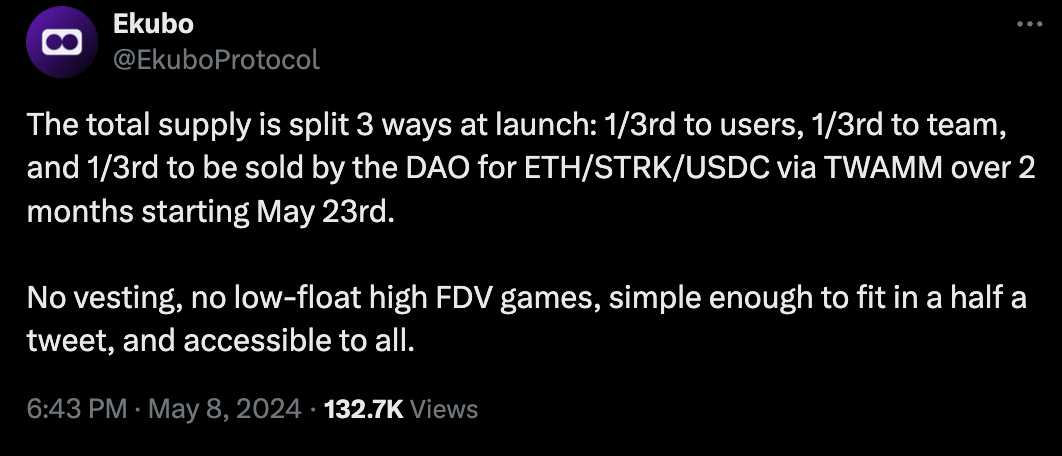
Not everyone liked the idea of 2 months of dumping, but it’s sort of a token sale to the community, similar to the past ICOs.
Similarly, Nostra (also on Starknet) launched NSTR at 100% FDV with 25% of the allocation via airdrops and 12% sold during the Liquidity Bootstrapping Pool event.
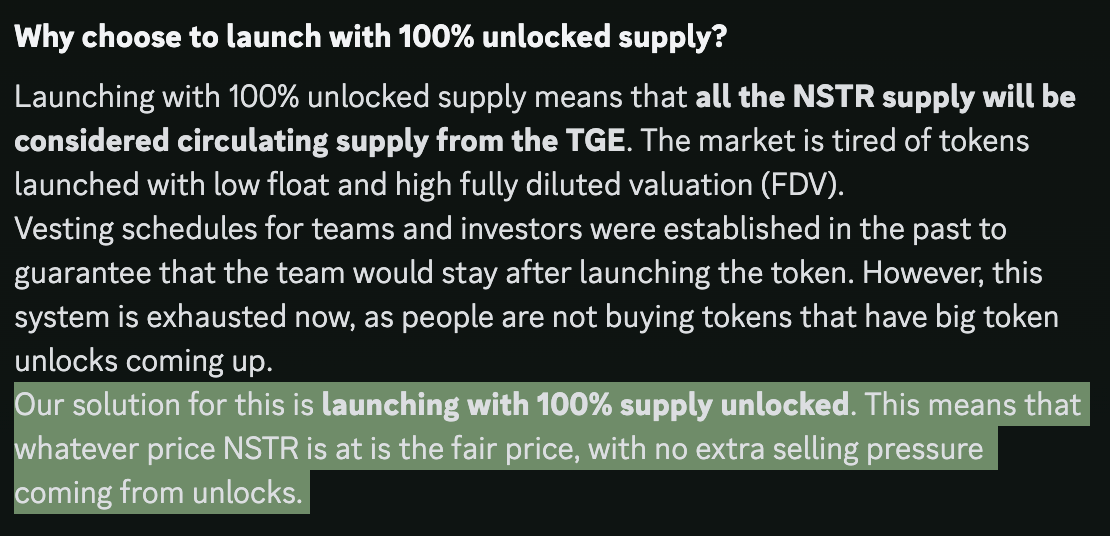
They call it the fairest launch in DeFi, yet it introduces concerns that led to low-float tokens in the first place (team, VCs cashing out early and exiting early). Nostra said that team and VC tokens will be tagged on chain.
If you see them selling, best to sell for you too.
We’ve also had 100% airdrop experiments by Friendtech and Bitcoin Runes are mostly all free to mint by the community (although Runes allow pre-mine as well).
What comes of it? Not sure. But there are sectors of hope.
Keep an eye on new token launch models - a new successful launch type could become the new meta for this bull run. And if you found some, please share in the comments.
6. McKinseys Coming to DeFi
DeFi enables self-sovereignty, allowing you to own and use your assets productively, regardless of country borders.
But DeFi is getting really complicated! So many strategies are available, and their complexity increases as we want to squeeze every % of the yield.
Plus, governing those increasingly complex protocols requires specific knowledge.
As a result, TradFi-like consulting companies sprung up to help protocols deal with security, governance, and optimization. The most famous case is Gauntlet, that charges millions per year for its clients.
What’s more, DeFi protocols are adapting by allowing McKinseys of DeFi to manage user assets or/and externalize risk management.
Morpho Blue permissionless lending allows McKinseys of DeFi to create markets with any assets and risk parameters without relying on governance.
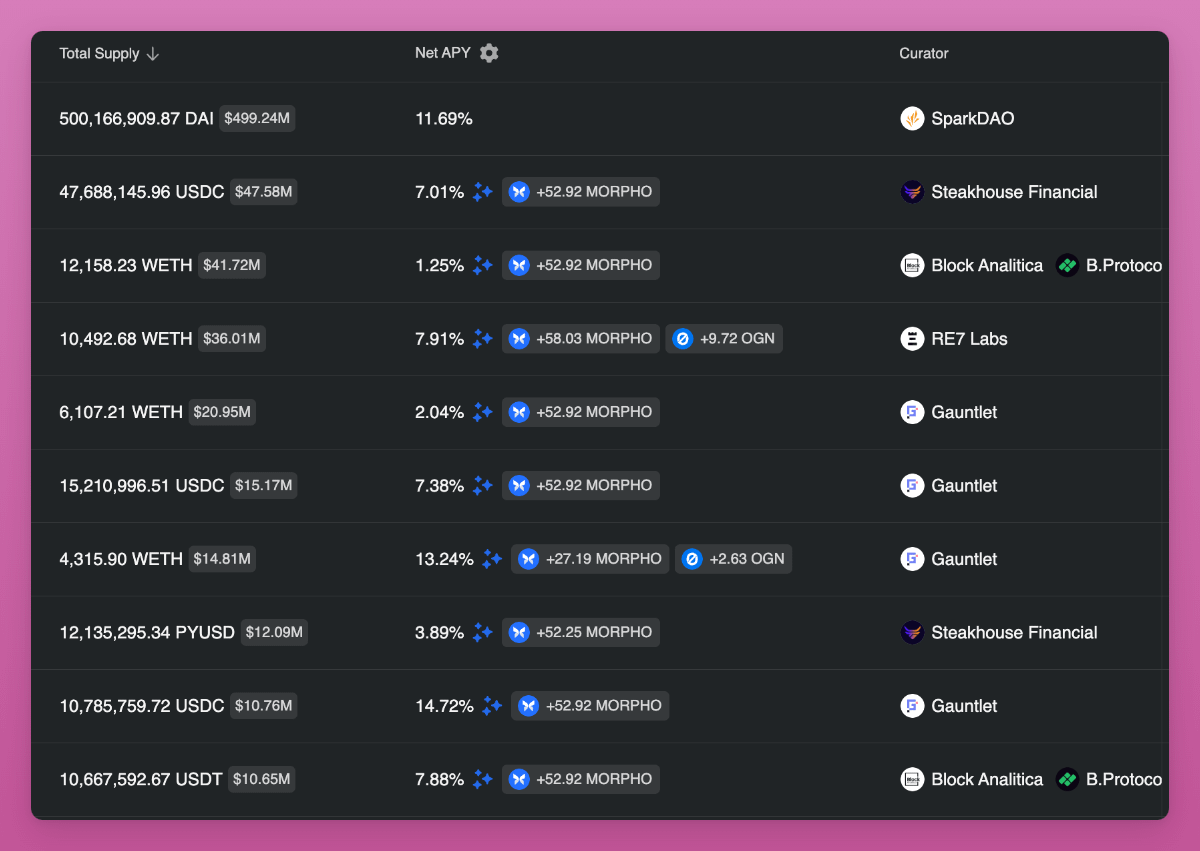 Morpho Blue
Morpho Blue
Most popular vaults are managed by Gauntlet, Steakhouse, RE7 Labs etc.
Similarly, Mellow protocol launched LRTs that are managed by ‘Curators’ enabling “depositors more flexibility regarding their desired level of exposure to risk, while still benefiting from the liquidity of staked assets.”
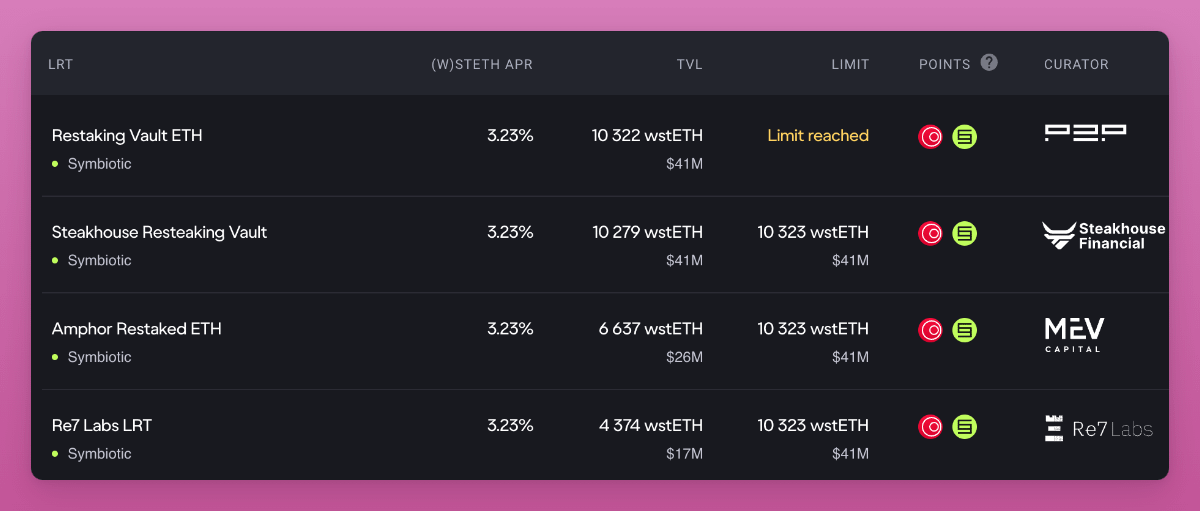
I believe this trend will grow with DeFi complexity increasing and further pushing “DeFi” towards “onchain finance.”
What could be the implications of it? One is the power migration from token holders to specialized companies. Does it make tokens less desirable? Or more attractive, as McKinzeys to DeFi help to grow protocols in professional way and increase revenue generation for the DAO. I don’t know yet.
7. Web2-like Onboarding to DeFi
This one I really like.
While Friend tech may have its problems, it has successfully popularized Privy, which enables the creation and management of wallets using Web2 accounts.

During the NFT mania, I helped friends to buy NFTs on OpenSea. Teaching how to use Metamask was such a pain.
But now, you can create a wallet with an email and 2FA code on Opensea with Privy. Seriously, go try it out. Took me a minute.
Fantasy Top is leveraging Privy and other user-oriented apps.
This trend extends beyond Privy.
Infinex, developed by Synthetix, allows wallet creation with Passkeys, so you simply use a password manager for your wallets.
Coinbase has launched Smart Wallet, which enables paying gas fees on behalf of users, supports batched transactions, and allows wallet creation with Web2 tools.
Now, complex user onboarding is no longer an excuse for the lack of crypto adoption. We simply need unique consumer apps.











